Three Yoga Poses to do After Masters Workout
Lengthen and relax your muscles to reduce soreness and retain flexibility
Doing a few yoga poses or asanas that lengthen muscles and connective tissue is an ideal way to relax your body and mind after your swimming workout. Performing the series of poses below regularly can help you to improve or retain good flexibility and reduce muscle tightness and soreness.
These three asanas are also beneficial to perform after competition. They should be avoided pre-race (or pre-training) to avoid the temporary reduction in muscle strength that occurs after sustained static stretching. When swimming in multiple races at a meet, perform these poses after all your events are completed.
Downward Facing Dog (Adho Mukha Shvanasana)
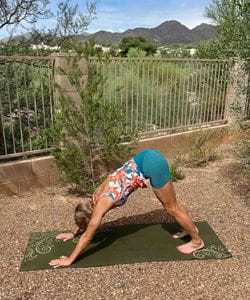
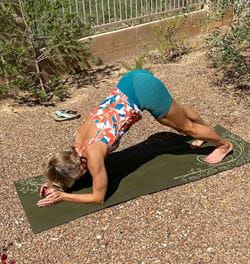
Your shoulder joint needs to be fully supported and balanced by surrounding muscles to endure the repetitive upper body movements required of all four swimming strokes. Downward facing dog improves shoulder joint range of motion and stability. It also stretches the muscles and tissues around your shoulder girdle, including the lats, pecs, rhomboids, posterior deltoids, and teres major, improving upper postural alignment and streamline position. Muscles in the lower back, hamstrings, and calves are also lengthened in this pose.
How
Start on your hands and knees with your hands shoulder-width apart (fingers spread) and feet hip-width apart. Curl your toes under, raise your knees and hips away from the mat, and position your sitting bones skyward. Slowly press your chest toward your thighs and heels down toward the floor, keeping hips high and your neck relaxed (so the crown of your head lengthens toward the floor, expanding the spaces between the cervical vertebrae). If you feel pressure on your low back, you can relieve this by softening or bending your knees. Always avoid locking your elbows and knees to reduce stress on joints.
If you’re experiencing discomfort or issues with your wrists, you can support yourself on your forearms rather than on your hands. This modified pose is known as the dolphin. Another option if downward facing dog and dolphin bear too much weight on your shoulders is to place the hands on a chair pushed up against a wall. Stay in your chosen version of the downward facing dog pose for five to 10 breaths.
Pigeon Pose (Kapotasana)
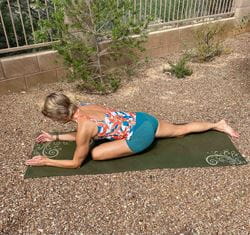
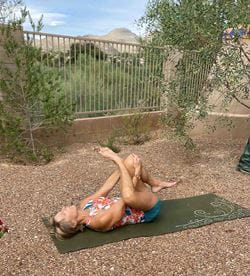
Pigeon pose is ideal for breaststrokers and any other swimmers who experience and want to alleviate uncomfortable tightness around in the hip joint. This asana opens the hip joint and stretches the gluteal and piriformis muscles.
How
Start from a downward facing dog pose or from the hands and knees if this is easier for you. Raise your right leg in the air and then bend your knee and step between your hands, setting the outside of the right foot down on your mat and opening your knee outward as much as is comfortable for your hip and knee. Slowly sink down on your elbows until your left leg is extended behind you and your right hip is very open, yet comfortable. If the stretch feels too intense on the knees and/or hips, you can place a block or folded yoga blanket underneath your left thigh to provide more lift and reduce pressure on the hip and knee joints. Stay here for 5 to 10 breaths. Place hands beside ears and push back up to downward dog. Repeat on the other side.
If you have had a hip or knee replacement or the pigeon is bothersome to your hips or knees, you can do the figure four stretch lying on your back. Bend your left knee and place your foot flat on the floor. Bend your right leg and place the side of your right foot on top of your left thigh, knee angled outward, to open the hip. Wrap hands (or a strap) around back of your left leg or front of your left knee and hug the knee in toward your chest to stretch your glutes and piriformis. Hold for five to 10 breaths. Release the stretch and switch sides.
Wide Stance Intense Stretch Pose (Padottanasana C)
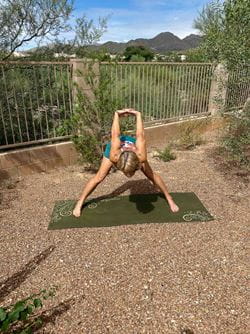
The C version of this Padottanasana pose will stretch your inner thigh muscles, open your hip joint, and lengthen muscles in your lower back as well as your chest and internal rotators. Avoid standing in too wide of a stance to avoid straining the adductors (inner thigh muscles). Breaststrokers should be particularly mindful of this.
How
Face the side of your mat and walk your feet into a comfortable straddle position with your toes positioned in front of your heels. Interlace your fingers behind your back (or press palms toward each other) and open the sides of the shoulders by squeezing your shoulder blades together. Exhale as you slowly hinge at the hips, tipping the torso and the clasped arms forward and overhead, lengthening through your spine. Think about opening your chest and lengthening from your sacrum to the crown of your head as you tip forward. Avoid hunching in the upper back or dropping your head forward. Keep your thigh muscles active and an even balance in the soles of the feet to create a balanced foundation for the pose. Avoid gripping with your toes. If discomfort is felt in your lower back, this can be alleviated with a slight knee bend. Hold the pose for 5 to 10 breaths.
Inhale, slowly come back up and exhale as you release your interlaced hands.
Categories:
- Technique and Training
SIGN UP FOR UPDATES FROM USMS


















